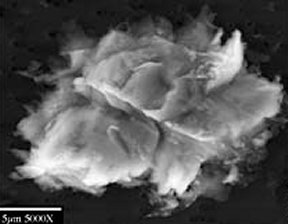This is an example of a microbe found at the South Pole.
Click on image for full size
Courtesy of NASA
Life at the South Pole?
News story originally written on July 14, 2000
Scientists discovered something that will have a big effect on our search for life on other planets.
Tiny microbes were found at the South Pole. These living organisms were thriving in the
harsh antarctic conditions. If these microbes can live here, then there is a chance
that similar organisms live in the cold regions of other planets, like Mars.
"If the team's conclusions prove true, the discovery not only has important implications for the search for life in
other extreme environments on Earth, but also for the possibility that life -- at
least at the microscopic level -- may
exist elsewhere in the solar system,"
the National Science Foundation (NSF)
said Thursday in a statement.
Scientists are amazed with the finding. Not only is it very cold at the South Pole, but large doses
of harmful radiation bombards the region. Not even this ultraviolet light can keep these little creatures from
surviving.
"While we expected to find some bacteria in the South Pole snow, we were surprised that they
were metabolically active and synthesizing DNA and protein at local ambient temperatures of 10.4
degrees to 1.4 degrees Fahrenheit ," Edward Carpenter of the State University of New York at Stony Brook said in the statement.
You might also be interested in:

It was another exciting and frustrating year for the space science program. It seemed that every step forward led to one backwards. Either way, NASA led the way to a great century of discovery. Unfortunately,
...more
The Space Shuttle Discovery lifted off from Kennedy Space Center at 2:19 p.m. EST, October 29th. The sky was clear and the weather was great as Discovery took 8 1/2 minutes to reach orbit for the Unitied
...more
A moon was discovered orbiting the asteroid, Eugenia. This is only the second time in history that a satellite has been seen circling an asteroid. A special mirror allowed scientists to find the moon
...more
Will Russia ever put the service module for the International Space Station in space? NASA officials are demanding an answer from the Russian government. The necessary service module is currently waiting
...more
During a period of about two days in early May, 1998, the ACE spacecraft was immersed in plasma associated with a coronal mass ejection (CME). The SWICS instrument on ACE, which determines unambiguously
...more
J.S. Maini of the Canadian Forest Service has referred to forests as the "heart and lungs of the world." Forests reduce soil erosion, maintain water quality, contribute to atmospheric humidity and cloud
...more
In late April through mid-May 2002, all five naked-eye planets are visible simultaneously in the night sky! This is includes Mercury which is generally very hard to see because of its proximity to the
...more















